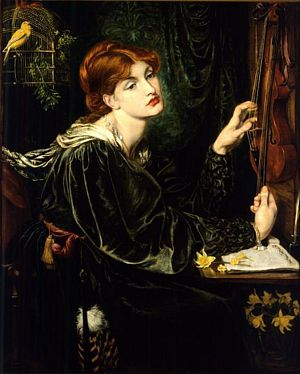С 1871 по 1874 годы Россетти создал четыре картины, изображающих женщин, играющих на музыкальных инструментах: La Girlandata, Veronica Veronese, The Bower Meadow и Roman Widow. Предполагалось, что их купит E. R. Layland , но он очень требовательно относился к цвету, размеру и форме картины, стремясь достичь определённого декоративного эффекта (он декорировал свой дом) он предпочёл картины с единственной женской фигурой и купил лишь Veronica Veronese, и Roman Widow.
The Bower Meadow 1871-1872.
Model: Alexa Wilding
Note: Alexa Wilding is the woman in the right foreground.
Model: Marie Spartali Stillman
Note: Marie Spartali Stillman is in the left foreground.
Ещё в 1849 году Россетти написал сонет к картине Mantegna "Parnassaus" (Mars and Venus), находившейся в Лувре.
Andrea Mantegna, Parnassus, 1497
Scarcely, I think; yet it indeed may be
The meaning reached him, when this music rang
Clear through his frame, a sweet possessive pang,
And he beheld these rocks and that ridged sea.
The sonnet concludes with a statement of the primacy of the heart over the mind:
It’s meaning filleth it,
A secret of the wells of Life: to wit:-
The heart’s each pulse shall keep the sense it had
With all, though the mind’s labour run to nought. (Collected Poetry 184)
В сонете Россетти делает акцент на фоне и танце женщин. Опубликован в "The Germ".
"The Bower... Россетти писал на холсте, где уже был изображён пейзаж Sevenoaks для предполагаемой картины на сюжет из Данте.
Возможно почувствовать влияние "The Mill" (1870)
Бёрн-Джонса, который в свою очередь восхищался "The Maids of Elfen-Mere"
 Veronica Veronese
Veronica Veronese
The painting is one of the most important among the many Venetian-inspired pictures that dominate DGR's artistic output during the 1860s and 1870s. Elaborately decorative, it is an excellent example of the abstract way DGR handles ostensibly figurative subject matter. As its various commentators have noticed, the picture represents “the artistic soul in the act of creation” (Ainsworth 97). It is a visionary portrait of that soul as it had been incarnated in the practise of Paolo Veronese.
Production History
Begun in January 1872 without any explicit commission, the painting was bought by Frederick Leyland as soon as DGR told him about it, and described his intentions for the work. DGR completed it in March of the same year and sent it to Leyland at that time.
Iconograpic
The French quotation on the picture frame, supposedly from The Letters of Girolamo Ridolfi, was actually written by DGR or possibly Swinburne. It constitutes a kind of explanation of some of the picture's most important iconographical features: “Suddenly leaning forward, the Lady Veronica rapidly wrote the first notes on the virgin page. Then she took the bow of her violin to make her dream reality; but before commencing to play the instrument hanging from her hand, she remained quiet a few moments, listening to the inspiring bird, while her left hand strayed over the strings searching for the supreme melody, still elusive. It was the marriage of the voices of nature and the soul—the dawn of a mystic creation” (this is Rowland Elzea's translation of the French text on the picture frame). The “marriage” noted here is emblematically represented in the figure of the uncaged bird, which stands simultaneously as a figure of nature and of the soul.
Sarah Phelps Smith has explicated the picture's flower symbolism: the bird cage is decorated with camomile, or “energy in adversity”; the primroses symbolize youth and the daffodils (narcissi) stand for reflection or meditation. But David Nolta argues that the camomile is in fact celandine, which in herbal lore was a notable specific for diseases of the eyes. (Nolta's autobiographical reading of the picture is greatly strengthened by this view of the flower symbolism.)
Pictorial
The green velvet dress in the picture was borrowed from Jane Morris, the background drapery is a Renaissance brocade, the jewelry is Indian silver, the violin is from DGR's collection of musical instruments. The fan hanging at her side is the same as that which appears extended in Monna Vanna . The musical manuscript showing the first bars of a composition seems in debt to George Boyce, to whom DGR wrote in March 1872 asking if he “had any old written music & could you lend me such” (quoted in Surtees, A Catalogue Raisonné I. 128).
Literary
The french inscription attributed to Girolamo Ridolfi is almost certainly the work of Swinburne.
Начата в январе 1872 года без определённого заказа